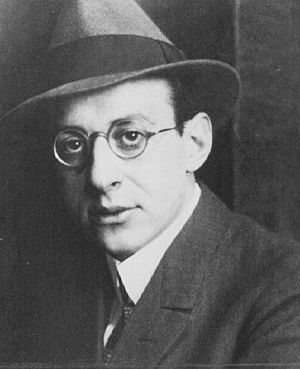Fritz Perls facts for kids
Quick facts for kids
Fritz Perls
|
|
|---|---|

Perls in 1923
|
|
| Born | July 8, 1893 Berlin, German Empire
|
| Died | March 14, 1970 (aged 76) |
| Known for | Coining term: Gestalt Therapy |
| Spouse(s) | Laura Perls |
| Scientific career | |
| Fields | Psychiatry, psychotherapy |
| Influences | Wilhelm Reich, Kurt Lewin, Jacob L. Moreno, Otto Rank, Gestalt Psychology |
Friedrich Salomon Perls (born July 8, 1893 – died March 14, 1970) was a German doctor. He was better known as Fritz Perls. He became a psychiatrist, a doctor who helps people with mental health. Perls also worked as a psychotherapist, which means he helped people understand their thoughts and feelings.
Fritz Perls created a special type of therapy called "Gestalt therapy". He developed this with his wife, Laura Perls, in the 1940s and 1950s. Gestalt therapy helps people become more aware of what they are feeling and doing right now. It focuses on how people connect with themselves and the world around them. Perls worked at the Esalen Institute from 1964 to 1969.
Contents
Fritz Perls' Early Life and Education
Fritz Perls was born in Berlin, Germany, in 1893. He grew up in a lively art scene in Berlin. He was part of art movements like Expressionism and Dadaism. These movements often had new and revolutionary ideas.
Perls faced challenges because he was Jewish. He also experienced the difficulties of war. These events greatly shaped his life. His family expected him to become a lawyer. But Perls chose to study medicine instead.
He joined the German Army during World War I. He served in the trenches, which was a very tough experience. After the war ended in 1918, he finished his medical studies. He graduated two years later. Perls specialized in neuropsychiatry, which deals with brain and mental health.
He then worked with Kurt Goldstein. Goldstein helped soldiers who had brain injuries. Perls became very interested in psychoanalysis. This is a way of understanding how past experiences affect a person's mind.
Developing His Ideas and Moving Abroad
In 1927, Perls joined seminars led by Wilhelm Reich. Reich's ideas about understanding a person's character greatly influenced Perls. By 1930, Reich became Perls' main teacher in Berlin.
In 1930, Perls married Laura Perls. They had two children, Renate and Stephen. In 1933, the Hitler regime came to power in Germany. Because they were Jewish and against the fascists, Perls and his family had to leave.
They first fled to the Netherlands. A year later, they moved to South Africa. There, Perls started a training center for psychoanalysis. In 1936, he had a short meeting with Sigmund Freud. Freud was a very famous psychoanalyst.
In 1942, Perls joined the South African army. He worked as an army psychiatrist until 1946. While in South Africa, he learned about "holism" from Jan Smuts. Holism is the idea that parts of something are closely connected. They can only be understood by looking at the whole.
During this time, Fritz Perls wrote his first book. It was called Ego, Hunger, and Aggression. It was published in 1942 and again in 1947. Laura Perls wrote two chapters for the book. However, she was not given credit when it was republished in the United States.
Creating Gestalt Therapy
Fritz and Laura Perls left South Africa in 1946. They moved to New York City. Fritz Perls worked briefly with Karen Horney and Wilhelm Reich there. After some traveling, he settled in Manhattan.
Perls wrote his second book with help from Paul Goodman. Goodman wrote the second part of the book based on Perls' notes. Perls and Goodman were influenced by Kurt Lewin and Otto Rank. The book was called Gestalt Therapy. It was published in 1951.
After this, Fritz and Laura Perls opened the first Gestalt Institute. It was in their apartment in Manhattan. Fritz Perls began traveling across the United States. He led workshops and training sessions for Gestalt therapy.
In 1960, Fritz Perls moved to Los Angeles. He worked with Jim Simkin there. In 1963, he started offering workshops at the Esalen Institute in Big Sur, California. Perls became interested in Zen during this time. He included the idea of mini-satori in his practice. A satori is a brief moment of awakening or understanding. He also visited a Zen monastery in Japan.
Eventually, he lived at Esalen and built a house there. One of his students was Dick Price. Price developed Gestalt Practice, based on Perls' teachings. At Esalen, Perls also worked with Ida Rolf. She created Rolfing, a method that looks at the connection between the mind and body.
In 1969, Perls left Esalen. He started a Gestalt community in Canada. It was at Lake Cowichan on Vancouver Island. There, he made eight educational films about his Gestalt therapy.
Fritz Perls passed away in Chicago on March 14, 1970. He died from heart failure after heart surgery.
Selected Books by Fritz Perls
- Perls, F., Ego, Hunger and Aggression (1942, 1947) ISBN: 0-939266-18-0
- Perls, F., Hefferline, R., & Goodman, P., Gestalt Therapy: Excitement and Growth in the Human Personality (1951) ISBN: 0-939266-24-5
- Perls, F., Gestalt Therapy Verbatim (1969) ISBN: 0-911226-02-8
- Perls, F., In and Out the Garbage Pail (1969) ISBN: 0-553-20253-7
- Perls, F., The Gestalt Approach and Eye Witness to Therapy (1973) ISBN: 0-8314-0034-X
See also
 In Spanish: Fritz Perls para niños
In Spanish: Fritz Perls para niños

